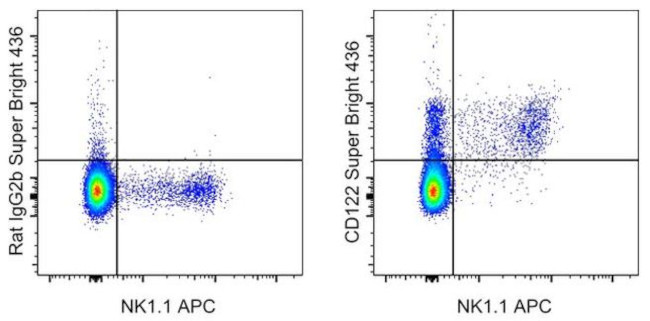Search Thermo Fisher Scientific
Invitrogen
CD122 Monoclonal Antibody (TM-b1 (TM-beta1)), Super Bright™ 436, eBioscience™
FIGURE: 1 / 1
CD122 Antibody (62-1222-82) in Flow

Product Details
62-1222-82
Species Reactivity
Host/Isotype
Recommended Isotype Control
Class
Type
Clone
Conjugate
Excitation/Emission Max
Form
Concentration
Purification
Storage buffer
Contains
Storage conditions
Shipping conditions
RRID
Product Specific Information
Description: The TM-b1 monoclonal antibody reacts with mouse CD122, the 90-110 kDa interleukin-2 receptor beta chain (IL-2R beta). CD122 is expressed by NK cells and some T cells in the periphery, and is upregulated by activation. CD122 associates with CD25 and CD132 (common gamma chain) to form the high affinity IL-2 receptor. High affinity binding of IL-2 to the IL-2 receptor is inhibited by the TM-b1 antibody.
Applications Reported: This TM-b1 antibody has been reported for use in flow cytometric analysis.
Applications Tested: This TM-b1 antibody has been tested by flow cytometric analysis of mouse splenocytes. This may be used at less than or equal to 1 µg per test. A test is defined as the amount (µg) of antibody that will stain a cell sample in a final volume of 100 µL. Cell number should be determined empirically but can range from 10^5 to 10^8 cells/test. It is recommended that the antibody be carefully titrated for optimal performance in the assay of interest.
Super Bright 436 can be excited with the violet laser line (405 nm) and emits at 436 nm. We recommend using a 450/50 bandpass filter, or equivalent. Please make sure that your instrument is capable of detecting this fluorochrome.
When using two or more Super Bright dye-conjugated antibodies in a staining panel, it is recommended to use Super Bright Complete Staining Buffer (Product # SB-4401) to minimize any non-specific polymer interactions. Please refer to the datasheet for Super Bright Staining Buffer for more information.
Excitation: 405 nm; Emission: 436 nm; Laser: Violet Laser
Super Bright Polymer Dyes are sold under license from Becton, Dickinson and Company.
Target Information
CD122 (Interleukin 2 receptor) is involved in T cell-mediated immune responses, primarily expressed in the hematopoietic system and is present in 3 forms. The low affinity form of CD122 is a monomer of the alpha subunit and is not involved in signal transduction. The intermediate affinity form consists of an alpha/beta subunit heterodimer, while the high affinity form consists of an alpha/beta/gamma subunit heterotrimer. Both the intermediate and high affinity forms of the receptor are involved in receptor-mediated endocytosis and transduction of mitogenic signals from CD122. The protein encoded by the CD122 gene represents the beta subunit and is a type I membrane protein. Diseases associate with CD122 protein dysfunction include oligoarticular juvenile idiopathic arthritis and rheumatoid factor negative juvenile idiopathic arthritis.
For Research Use Only. Not for use in diagnostic procedures. Not for resale without express authorization.
How to use the Panel Builder
Watch the video to learn how to use the Invitrogen Flow Cytometry Panel Builder to build your next flow cytometry panel in 5 easy steps.
References (0)
Bioinformatics
Protein Aliases: CD122; High affinity IL-2 receptor subunit beta; IL-15 receptor beta chain; IL-2 receptor beta chain; IL-2 receptor subunit beta; IL-2/15 receptor-beta; IL-2R subunit beta; IL-2RB; Interleukin-2 receptor subunit beta; p70-75
Gene Aliases: CD122; IL-15Rbeta; Il-2/15Rbeta; Il-2Rbeta; IL15Rbeta; Il2rb; p70
UniProt ID: (Mouse) P16297
Entrez Gene ID: (Mouse) 16185

Performance Guarantee
If an Invitrogen™ antibody doesn't perform as described on our website or datasheet,we'll replace the product at no cost to you, or provide you with a credit for a future purchase.*
Learn more
We're here to help
Get expert recommendations for common problems or connect directly with an on staff expert for technical assistance related to applications, equipment and general product use.
Contact tech support

